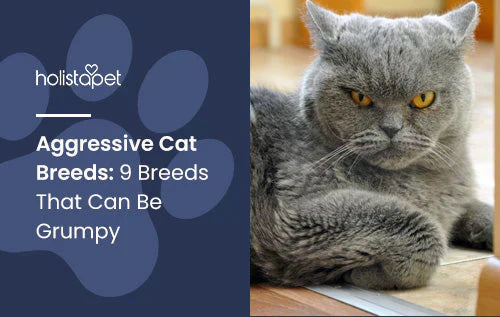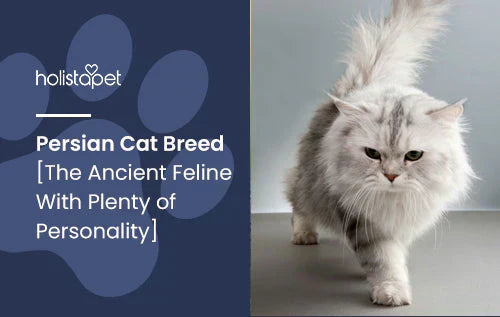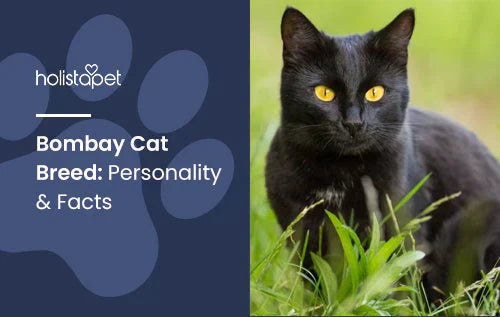Swatting. Hissing. Scratching. Many people don't understand cat behavior and therefore are confused as to why their cat becomes angry. Is it something that happened? Is it something I did? Or is it just that my cat is genetically a grump sour-puss? Are there aggressive cat breeds in my cat's ancestry? So many questions and the answers are difficult to sniff out.
As it becomes more popular for people to buy purebred cats, the differences between breeds of feline are becoming more apparent. The Siamese breed is super loud; Ragdolls love to cuddle, and Persians are sort of lazy. Turkish Vans love to swim and play. So is it possible that some cat breeds are also more aggressive than others?
Understanding Aggression Across Different Cat Breeds
Not all cat breeds exhibit the same levels of aggression. While some cats may display aggressive behaviors due to various factors, aggression is not inherently linked to specific breeds. Aggression in cats can result from several causes, including:
- Genetics: Certain breeds may have a predisposition to be more territorial or assertive, but this is not a rule for every cat within the breed.
- Socialization: Cats that are not properly socialized during their early developmental stages may show more aggressive behaviors.
- Environment: A cat's surroundings and living conditions can significantly influence its behavior. Stressful environments or changes in routine can trigger aggression.
- Health Issues: Pain or discomfort from underlying medical conditions can cause a cat to act aggressively.
- Past Experiences: Traumatic or negative experiences can lead to defensive or aggressive behaviors.

What Are the Most Aggressive Cat Breeds?
No cat breed is known for outright aggression. But some cat breeds are quicker to snap or lash out than others. Here are some of the cat breeds that have a reputation for being a bit more grumpy than the average cat (if given a reason).
Siamese
The Siamese cat is known to be the most aggressive of all cat breeds, likely due to the breed's tendency to get very jealous of other pets. Siamese cats are needy and clingy, becoming very attached to their favorite human. And they don't want to share! If they see you petting another cat or hanging out with a human, your Siamese may lash out in an attempt to get attention back on them.
Sphynx
This breed is very demanding, which doesn't just mean taking extra care of their skin due to a lack of fur. It also means the Sphynx cat always wants to be the center of attention. If they're not getting the attention they desire, the Sphynx will act out to get what they want. While not aggressive in a violent way, many people would find the behavior "irritating."
Bengal
The Bengal cat is large and feels as if it still belongs in the wild. F1, F2, and F3 Bengals are not considered domesticated because of the large amount of Asian Leopard Cat in their blood. But even F4 and F5 Bengals have a bit of a destructive streak. Behavioral issues like territorial spraying and play aggression are quite common if this Boat breed doesn't meet its needs. The Bengal is notoriously high maintenance, so you'll need to put a lot of time into this cat to avoid aggressive behavior.
Scottish Fold
It's probably surprising to see the Scottish Fold here. They have plump faces, chubby cheeks, and big, owl-like eyes. But the Scottish Fold is more than just a teddy bear-faced feline. This breed is quite sensitive to change and may become aggressive when new pets are brought home. This cat is also not the friendliest toward babies and children. The Scottish Fold doesn't like to share the attention and is also fond of rough petting.
Pixie Bob
Playful and active, Pixie Bobs are often quite social with their family. More so, Pixie Bobs are very suspicious of strangers. You will probably hear the Pixie Bob growling at strangers when they visit your home. While not violently aggressive, this cat will let you know how they are feeling with their unique vocals.
Egyptian Mau
This elegant and striking cat has a very strong bond with its family. While they appear gentle with loved ones and even shy with strangers, the Egyptian Mau may become a bit mean if you try to take their food or toys. That's because the Egyptian Mau is pretty protective of their things.
Singapura
The Singapura breed is the smallest cat breed in the world. This sweet and shy kitty may become aggressive if they feel threatened. This breed is wary of strangers and may get easily startled. It's important to socialize your Singapura as a kitten, so they don't take to hiding or defensively scratching.
Bombay
The Bombay cat breed looks dark and mysterious like a jaguar, but this breed is much more affectionate. And unlike wild cats, the Bombay is a bit sensitive. They are often startled by loud noises and sudden noises in general. The Bombay might lash out in fear when it hears a noise that startles them.
Turkish Van
A recent study of over 40 breeds found that Turkish Vans were the most likely to display aggression towards people and other cats. The Turkish Van is a cat that prefers to be the only cat in the household. They are also fond of strangers. Ensure that you properly socialize your Turkish Van as a kitten, so they don't become territorial when a stranger enters the home.

What Causes Aggressive Behavior in Cats?
By nature, cats are not aggressive. Most cats are friendly with their immediate family and shy around strangers (at least at first). When a cat acts aggressively, it's not out of nowhere. It's usually a reaction to something that happened. It's important to understand your cat's behavior to figure out what caused the aggression.
Why Is My Cat So Defensive?
The most common reason that a cat becomes aggressive is due to fear. Most aggression is defensive instead of offensive. Here are some things that cause cats to become defensive:
- Loud noises: Many cats, especially some breeds, are sensitive to sudden, loud noises. If you're near a cat when they hear a loud noise, they may scratch you in an attempt to get away and then run to a hiding spot.
- Strangers in the house: Cats are often wary of new people and may become defensive. If approached by a random person, your cat may lash out in an attempt to get them to back off.
- Feeling cornered: If a cat feels cornered in general during a time when it wants to be left alone, you should look at their body language. Before scratching, cats usually warn you to back off by flicking their tail, widening their eyes, arching their back, and putting their ears back.
- New pets: A lot of cats heavily dislike change. This includes bringing a new pet into their territory. Your cat may try to assert dominance or protect their space by lashing out at the newcomer.
- Discomfort: Cats are experts at hiding their discomfort, even if it's a serious illness. But sometimes, if you touch a certain spot on your cat's body, it may trigger them to automatically bite or scratch you.
- Boredom: If your cat isn't stimulated enough, they may become destructive to entertain themselves or get your attention. This could include ripping at furniture or attacking at feet as you walk by.
Why Are Some Cat Breeds More Prone to Aggressiveness Than Others?
Cat behavior hasn't been as extensively studied as dog behavior, so many things cats do are seen as a mystery. From their nightly peruse around the house each night to their constant scratching and fondling of cardboard — cat's are interesting to say the least. Cats were domesticated about 10,000 years ago. In more recent years, humans started selectively breeding cats to intentionally create various cat breeds with distinctive appearances and personalities.
The International Cat Association recognizes 71 breeds, all bred to behave and appear a certain way. While not much research has gone into cat behavior, breeders, owners, and vets have all reported distinctive behaviors for each cat breed over the years. While more studies are needed to truly understand cat genetics and each breed's personality, it's quite clear that each cat breed has pretty specific behavior based on genetics.

Types of Aggression in Cats
Cats typically display aggression as a defense mechanism rather than an offensive one. It's uncommon for a cat to attack someone without provocation. Even wild cats tend to hide when they sense danger rather than engage in a fight. Here are some common types of aggression observed in cats:
- Fear-Induced Aggression: Cats may lash out when they feel threatened or cornered. This type of aggression is driven by fear, and you might notice the cat's body language, such as a puffed-up tail or flattened ears, signaling distress.
- Territorial Aggression: Cats are territorial animals and may become aggressive when they feel their space is being invaded. This can occur when a new pet is introduced into the home or when a cat encounters another animal outside.
- Redirected Aggression: Sometimes, a cat may be agitated by something it cannot reach, such as a bird outside a window. In these cases, the cat might redirect its aggression toward a nearby person or pet.
- Play-Induced Aggression: Young cats and kittens often exhibit aggressive behavior during play, which can involve biting and scratching. This behavior is usually a part of their natural hunting instinct and energy, though it should be managed to avoid injury.
- Pain-Induced Aggression: Cats in pain may react aggressively when touched or handled, as they associate the interaction with discomfort. This type of aggression can be seen in cats suffering from health issues or injuries.
- Maternal Aggression: A mother cat may become highly protective and aggressive when she feels her kittens are threatened. This behavior is instinctual and typically subsides as the kittens grow.
Why Is My Cat Breed So Aggressive?
There are some common reasons that cats become aggressive, each one pretty defensive in nature. It's important to understand cat behavior and read your cat's body language so you can quickly spot your cat being defensive before they lash out. This will stop a lot of aggression from ever happening.
- Stress: A cat feeling overwhelmed will often try to hide or want to be left alone. If approached, a stressed cat will flick its tail and make itself look smaller by curling into a ball. The stress may be from a new pet in the home or a child playing too rough.
- Fear: Cats that have just heard a loud noise, had an encounter with the vacuum, or were just barked at by a visiting dog will often react by hiding. They will warn you to back off by flattening their ears, arching their back, and fluffing up their tail. You can provide your cat CBD calming treats.
- Territorial: Cats become attached to places. They consider your home to be their territory. If a new pet comes into the home or even a new human, your cat may become territorial. They'll hiss, growl, and bristle up, warning the newcomer to back off.
- Anger: When a cat becomes angry, they will warn you to leave them alone before attacking. But sometimes, we don't read their body language quickly enough. Look for dilated pupils, flattened ears, licking of the lips, and spiky fur along their spine. If you hear a low grumble, back away immediately.
How Do You Calm Down Aggression in Cats?
Getting scratched by a cat hurts! So, how can you avoid further damage and destruction from your aggressive kitty? There are luckily a lot of ways to calm down a cat that seems on edge. Here are some things you can do immediately.
Read Your Cat's Body Language
The most important thing you can do is pay close attention to your cat's body language. If you notice your cat looking stressed or angry, you should just back away. This will reduce the tension and stop your cat from lashing out. Back away from your cat and give it space if you notice:
- Flicking tail
- Flattened ears
- Dilated eyes
- Licking lips
- Baring teeth
- Hissing
- Growling
- Heavy breathing
- Arched back
- Raised fur along the spine
- Fluffed up tail
- Swatting
Give Your Cat Space
If your cat was just frightened by fireworks or getting its tail pulled by a toddler, it's best to give your cat time to come out of hiding on their own. If your cat goes to hide, trying to pull them out and cuddle them will only overwhelm them. Their instinct is to hide, so let them do what allows them to feel safe and comforted.

Don't Yell
If you scream at your cat or yell, your cat will become even more frightened. This will make your cat even more defensive, making it more likely for them to become aggressive if you approach.
Give Them CBD Treats
Once your cat has calmed down a little bit, try giving them some CBD treats. CBD is a natural compound within the hemp plant that will comfort your cat, leaving them calm and relaxed. CBD, or cannabidiol, indirectly supports your cat's endocannabinoid system or ECS. The ECS is in charge of their homeostasis (internal balance), and its function is crucial for overall wellbeing. CBD interacts with receptors in your cat's body, and this interaction boosts the ECS's functionality.
A healthy ECS results in a kitty with a better mood! Give your cat CBD treats twice a day or every eight hours to reduce destructive and aggressive behavior. You can also give your cat CBD oil mixed in their breakfast and dinner. CBD catnip spray is another fun way to provide your cat with a consistent dose of CBD each day. Spray it on their favorite scratcher or toy.
Final Thoughts - Aggressive Cat Breeds
Every cat has a unique personality. Some love cuddles, others prefer to hang out nearby but out of petting distance. And some cats love to play all day, while others struggle to bat at a ribbon for more than a few minutes. Some cats are quite vocal and demanding, while some barely make a sound. But there have been studies that prove that a cat's breed does play a part in their personality.
While cats are not aggressive by nature, some breeds are more prone to acting aggressively than others. For example, Siamese cats may be very demanding and will do whatever it takes to get the attention they want. And some Bombays might lash out in fear if they hear a loud noise. Luckily there are ways to soothe an aggressive cat.
Give them space, provide them with CBD, and understand the reason behind their behavior. But if your cat seems to be acting differently than usual, it may also be a behavioral issue or underlying illness. Reach out to your vet if you think something serious is going on with your feisty feline.


 CBD Oil for Cats - Fast Acting
CBD Oil for Cats - Fast Acting
 CBD Cat Treats - Easy Dose
CBD Cat Treats - Easy Dose
 CBD Calming Chews for Cats - Highly Rated
CBD Calming Chews for Cats - Highly Rated
 CBG Oil for Dogs and Cats - Loved by Thousands
CBG Oil for Dogs and Cats - Loved by Thousands





Leave a comment
All comments are moderated before being published.
This site is protected by hCaptcha and the hCaptcha Privacy Policy and Terms of Service apply.